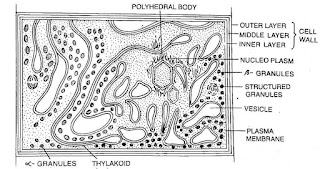Oscillatoria Unveiled A Close Examination of Its Intricate Structure
Oscillatoria, a filamentous cyanobacterium, exhibits unique characteristics that contribute to its ecological significance. This essay provides a comprehensive exploration of Oscillatoria, covering its habitat preferences, general structure, cell structure, and reproductive strategies.
Habitat:
Oscillatoria is commonly found in diverse aquatic habitats,
demonstrating a broad ecological range. Thriving in both freshwater and marine
environments, it forms slimy, greenish filaments that attach to various
substrates such as rocks, sediments, and aquatic vegetation. The adaptability
of Oscillatoria allows it to endure a wide range of temperature and light
conditions. It often forms extensive mats on surfaces, contributing to its
ecological role in nutrient cycling and water quality regulation.
General Structure:
The general structure of Oscillatoria is characterized by
its filamentous morphology:
- Filamentous
Form: Oscillatoria typically exists as long, unbranched filaments
composed of cylindrical cells. These filaments may intertwine, forming
mats or colonies on surfaces.
- Blue-Green
Coloration: The presence of pigments like chlorophyll a and
phycocyanin gives Oscillatoria its distinctive blue-green color,
contributing to its ability to photosynthesize and convert light energy
into chemical energy.
- Slimy
Sheath: A protective slimy sheath surrounds the filament, providing
structural support and aiding in buoyancy. This sheath also helps in
retaining water, a crucial adaptation for survival in various aquatic
environments.
Cell Structure:
The individual cells within Oscillatoria filaments exhibit a
specific cellular arrangement:
- Cylindrical
Cells: The cells are cylindrical in shape, and each cell contains a
central vacuole. The arrangement of cells end-to-end forms the filamentous
structure.
- Cell
Wall: The cells are surrounded by a rigid cell wall made of
peptidoglycan, a characteristic feature of bacterial cells.
- Thylakoid
Membranes: Within the cells, thylakoid membranes house pigments
essential for photosynthesis. These pigments capture light energy, driving
the synthesis of organic compounds.
- Gas
Vacuoles: Some species of Oscillatoria possess gas vacuoles, which aid
in buoyancy regulation. This adaptation allows the filaments to move
vertically in the water column.
Reproduction:
Oscillatoria employs several reproductive strategies to
ensure its survival and dispersal:
- Binary
Fission: The most common method of reproduction in Oscillatoria is
binary fission. During this process, a single filament divides into two
daughter filaments, each genetically identical to the parent filament.
- Fragmentation:
Oscillatoria can undergo fragmentation, where portions of the filament
break off and can independently develop into new filaments. This mechanism
facilitates the colonization of new areas.
- Hormogonia Formation: Oscillatoria can produce specialized filaments called hormogonia. These hormogonia can break away from the parent filament, aiding in the dispersal and establishment of new colonies.










_Tode_1013949.jpg)


0 Comments